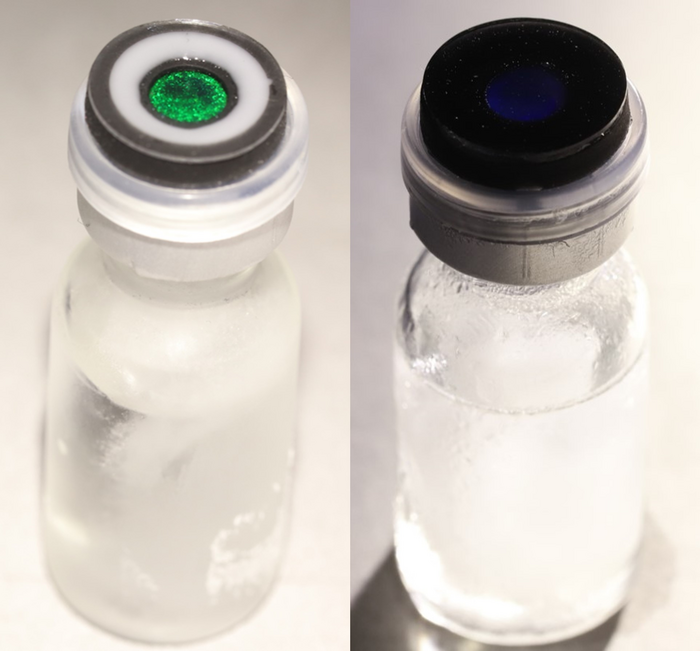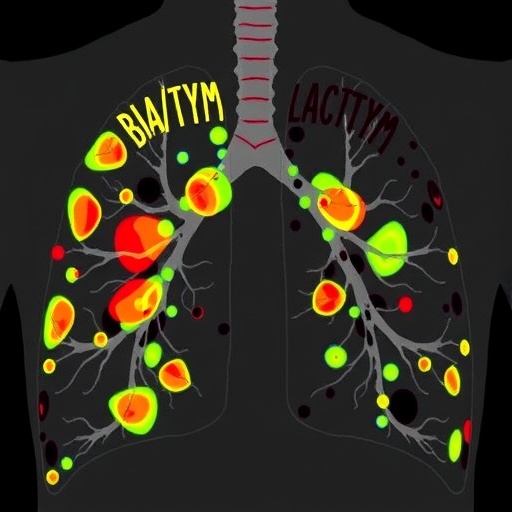Some foods and medicines, such as many COVID-19 vaccines, must be kept cold. As a step toward a robust, stable technique that could indicate when these products exceed safe limits, researchers in ACS Nano report a class of brilliantly colored microcrystals in materials that become colorless over a wide range of temperatures and response times. As a proof of concept, the team packaged the color-changing materials into a vial lid and QR code.

Credit: Adapted from ACS Nano 2023, DOI: 10.1021/acsnano.3c00467
Some foods and medicines, such as many COVID-19 vaccines, must be kept cold. As a step toward a robust, stable technique that could indicate when these products exceed safe limits, researchers in ACS Nano report a class of brilliantly colored microcrystals in materials that become colorless over a wide range of temperatures and response times. As a proof of concept, the team packaged the color-changing materials into a vial lid and QR code.
Walk-in freezers and refrigerated trucks generally maintain their set temperatures, but accidents can happen. Wireless sensors can monitor the temperature of individual products, but these devices produce a lot of electronic waste. Recently, researchers have suggested using materials that act as visual indicators to provide this information with less waste. Yet some current options using colorful reactions or dyes produce hues that can fade. Or they only track above-freezing temperatures, which isn’t useful for some COVID-19 vaccines that can actually start breaking down below freezing — above -4 or -94 degrees Fahrenheit. So, Yadong Yin, Xuemin Du and colleagues wanted to develop a better color-changing material with tunable melting to track a wide range of temperatures.
The researchers used structural colors, instead of dyes, for their indicator system. The team made glycerol-coated silicon dioxide nanoparticles, which appeared bright green or red when they clustered together into microcrystals in water. Next, they created liquids with variable melting points by mixing different proportions of polyethylene glycol or ethylene glycol and water. When these two parts were put together, they could produce an irreversible color loss when the temperature-triggered solution melted and the microcrystals broke apart. The materials could be customized to track temperature exposures from -94 to +99 degrees Fahrenheit that lasted from a few minutes to multiple days. In other experiments, the two-part indicator systems were packaged into flexible round vial labels and a QR code. These systems were very sensitive and successfully indicated when the materials got too warm. The researchers say that structural color-changing materials hold promise for the diverse scenarios encountered in medical cold supply chains.
The authors acknowledge funding from the National Natural Science Foundation of China, the National Key R&D Program of China, the Youth Innovation Promotion Association of Chinese Academy of Sciences, the Guangdong Regional Joint Fund-Key Project, the Chinese Academy of Sciences Key Laboratory of Health Informatics, the Shenzhen Institutes of Advanced Technology and the Fundamental Research Program of Shenzhen.
The paper’s abstract will be available on May 31 at 8 a.m. Eastern time here: http://pubs.acs.org/doi/abs/10.1021/acsnano.3c00467
The American Chemical Society (ACS) is a nonprofit organization chartered by the U.S. Congress. ACS’ mission is to advance the broader chemistry enterprise and its practitioners for the benefit of Earth and all its people. The Society is a global leader in promoting excellence in science education and providing access to chemistry-related information and research through its multiple research solutions, peer-reviewed journals, scientific conferences, eBooks and weekly news periodical Chemical & Engineering News. ACS journals are among the most cited, most trusted and most read within the scientific literature; however, ACS itself does not conduct chemical research. As a leader in scientific information solutions, its CAS division partners with global innovators to accelerate breakthroughs by curating, connecting and analyzing the world’s scientific knowledge. ACS’ main offices are in Washington, D.C., and Columbus, Ohio.
To automatically receive news releases from the American Chemical Society, contact [email protected].
Follow us: Twitter | Facebook | LinkedIn | Instagram
Journal
ACS Nano
DOI
10.1021/acsnano.3c00467
Article Title
Self-Destructive Structural Color Liquids for Time-Temperature Indicating
Article Publication Date
31-May-2023




